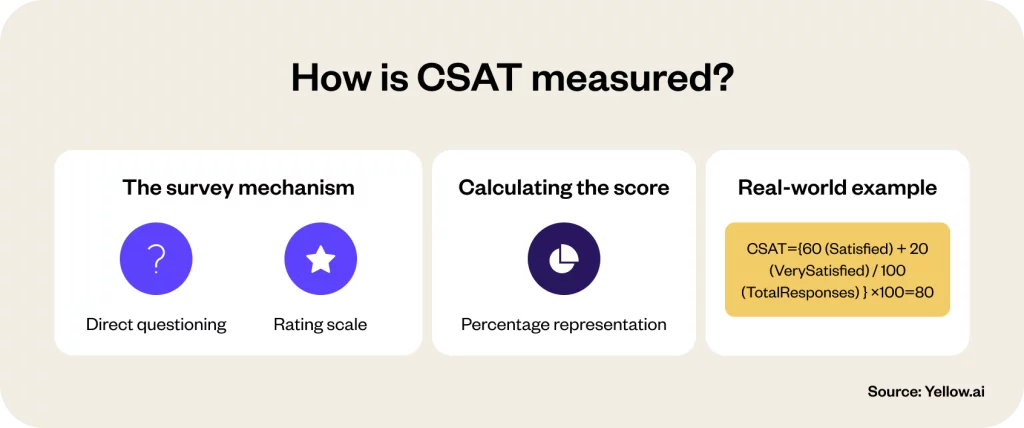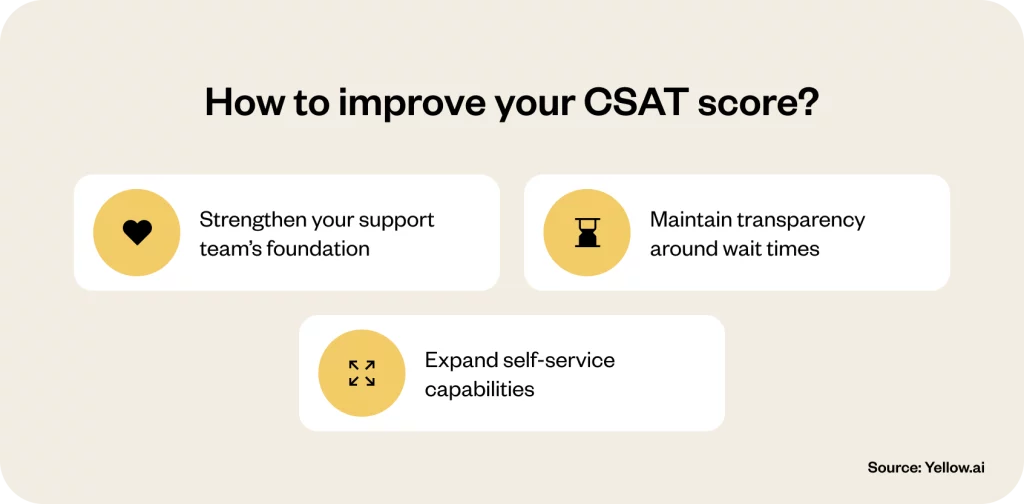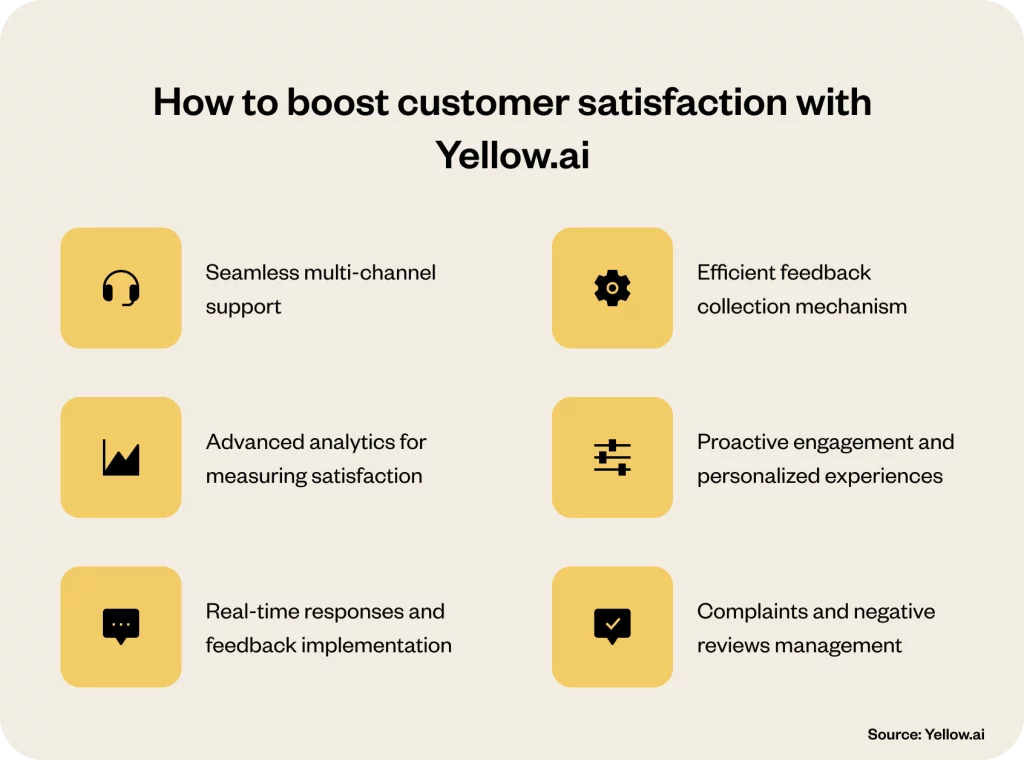Executive summary
Grasping the pulse of customer satisfaction hinges on the strategic use of Customer Satisfaction Scores (CSAT). This blog explains a strong CSAT score, methods for its calculation, and actionable strategies for enhancement. With a spotlight on its crucial role in refining customer experiences, we provide insights on leveraging CSAT scores to boost loyalty, improve services, and catalyze business growth. Dive in for an exploration of turning customer feedback into your business’s growth strategy.
Introduction
Imagine a world where customer feedback shapes the future of your business. That world is here, defined by something as simple yet profound as the Customer Satisfaction Score (CSAT). In the bustling business landscape of 2024, CSAT emerges as a beacon guiding companies toward understanding and enhancing customer satisfaction. No longer a cumbersome task, evaluating customer happiness has become an insightful journey, thanks to advancements in data analysis and customer feedback mechanisms.
Remember, it is not just about tallying up scores; it’s about unlocking the stories behind every rating, turning insights into action. The essence of CSAT lies in its ability to pinpoint where we delight customers and where we fall short. As we delve into this guide, we’ll explore how to accurately measure, interpret, and improve upon these scores. It’s time to make every customer interaction a stepping stone toward building lasting relationships and steering your business toward success.
What is a customer satisfaction (CSAT) score?
The Customer Satisfaction Score (CSAT) is a critical metric for gauging customer sentiments in today’s bustling business world. At its essence, CSAT quantifies the satisfaction level customers derive from a particular service, product, or experience with your company. This straightforward metric offers instant feedback, shining a spotlight on how well a business meets, exceeds, or falls short of customer expectations. Traditionally gathered post-interaction (be it a product purchase, support call resolution, or any other direct engagement), CSAT provides actionable insights that guide improvements in customer service strategies.
Understanding CSAT goes beyond merely collecting scores. CSAT is about decoding the pulse of customer satisfaction across various touchpoints. Whether navigating the sales process, using a new product, or engaging with customer support, CSAT acts as a litmus test for customer happiness. However, it’s essential to recognize that CSAT is part of a broader spectrum of customer experience metrics alongside Net Promoter Score (NPS) and Customer Effort Score (CES). Each of these metrics serves a unique purpose. That is because it captures different dimensions of the customer experience. Therefore, integrating CSAT with these complementary insights offers a holistic view of customer satisfaction and loyalty.
Related read: Customer loyalty: Importance & Strategies to increase
The real power of CSAT lies in its ability to pinpoint specific areas for enhancement. While high CSAT scores celebrate the strengths of a business, lower scores are a crucial wake-up call for areas needing attention. This direct feedback mechanism enables businesses to address and rectify shortcomings swiftly. That can turn potential negatives into opportunities for growth. By weaving CSAT data with other key performance indicators, companies can uncover deeper insights, ensuring that every decision is customer-centric. Remember, it is not just about achieving a high score but developing an environment where customer satisfaction is paramount. That will ultimately lead to sustained business success.
How to calculate satisfaction score (CSAT)?
Understanding the pulse of customer satisfaction is crucial for any business aiming to thrive in today’s competitive market. The Customer Satisfaction Score (CSAT) is vital. It guides companies by quantifying the seemingly qualitative aspect of customer sentiments. Simplified to its core, calculating CSAT doesn’t require intricate algorithms or data science expertise. It’s straightforward, yet it packs a wealth of insights. It enables businesses to measure the effectiveness of their services or interactions from the customer’s perspective.
At its essence, CSAT calculation involves a direct question posed to the customer, usually following a specific interaction or service experience. This question asks customers to rate their satisfaction level, typically on a scale that ranges from “Very Satisfied” to “Very Dissatisfied.” Clarity is key here; a scale that’s easy to understand ensures that customers provide accurate feedback without any confusion. For instance, using a precise numeric scale where a higher number denotes greater satisfaction or employing universally understood emojis can eliminate any ambiguity.
Formula to calculate CSAT score:
CSAT = (Total Number of Responses/Number of Satisfied Responses) × 100
Example: Imagine you conducted a survey and received 200 responses. Out of these, 160 customers indicated they were either “Satisfied” or “Very Satisfied.” Using the formula, you calculate your CSAT score as follows:
CSAT = (160/200) × 100 = 80%
This result, an 80% CSAT score, provides a tangible measure of how your customers feel about their recent interaction with your business. It’s a straightforward yet profound way to keep your finger on the pulse of customer satisfaction. It will enable you to identify strengths to build upon and areas needing improvement.
Why are CSAT scores important?
Customer Satisfaction Score (CSAT) is a critical yardstick for measuring the immediate sentiment of your customers toward your services or products. But why is this metric so vital for businesses? Let’s explore the importance of CSAT scores and how they serve as a linchpin in crafting a customer-centric strategy.

1. Unlocking customer sentiments
At its core, CSAT directly describes how your customers feel about their most recent interaction with your business. This instant feedback mechanism allows you to gauge satisfaction levels in real time, enabling quick fixes to issues before they escalate. Whether it’s a flaw in your product, a gap in your service, or an opportunity to enhance user experience, understanding customer sentiment guides immediate and informed actions. It prevents potential fallout and enhances customer trust.
Related read: How to measure customer sentiment?
2. Guiding strategic decisions
Data-driven decision-making is the backbone of any thriving business. CSAT scores offer concrete data on where your business stands in the eyes of your customers. This information is invaluable for steering strategic initiatives, be it refining your product, tweaking your marketing strategy, or enhancing your customer service approach. It is beyond just about fixing what’s broken. It is about amplifying what works, innovating, and staying ahead of customer expectations.
3. Identifying at-risk customers
High churn rates are a nightmare for any business. CSAT scores are an early warning system. They help you identify customers who are not fully satisfied and are at risk of taking their business elsewhere. By addressing their concerns proactively, you demonstrate your commitment to their satisfaction, turning potential detractors into loyal advocates.
4. Creating brand advocates
Satisfied customers are the most effective ambassadors for your brand. A high CSAT score indicates a customer base that’s content and enthusiastic about your offerings. Encouraging these satisfied customers to share their positive experiences can amplify your brand’s reach and attract new customers. It can turn your satisfied customer base into a powerful marketing tool.
How is CSAT measured?
Businesses are continually searching for reliable metrics that provide clear insights into how their services or products are received. One such feedback is the Customer Satisfaction Score (CSAT), a straightforward yet powerful tool for gauging customer sentiment. Understanding how to measure CSAT effectively is crucial for businesses aiming to refine their customer experience and develop positive relationships. Let’s understand the methodology behind CSAT measurement, making it accessible and actionable for businesses of all sizes.

Related read: How to measure customer satisfaction: Key metrics explained
The survey mechanism
Direct questioning
The crux of measuring CSAT lies in directly asking your customers how satisfied they were with a specific experience, service, or product. This inquiry is typically posed through a survey question following an interaction, purchase, or at set intervals to gauge ongoing satisfaction levels.
A standard question format is:
“How would you rate your overall satisfaction with the [service/product] you received?”
It offers a simple yet comprehensive snapshot of customer sentiment.
Rating scale
CSAT’s effectiveness lies in its straightforward approach to gathering customer feedback. Customers are presented with a precise, concise scale that spans from 1 (Very Unsatisfied) to 5 (Very Satisfied), allowing them to convey their level of satisfaction quickly. This user-friendly design not only simplifies the feedback process for customers but also enhances participation rates. As a result, businesses gain insights from a broad cross-section of their clientele, capturing a comprehensive snapshot of customer satisfaction levels.
Calculating the score
Percentage representation
The beauty of CSAT lies in its simplicity of calculation. The score is derived by tallying the positive responses (typically responses 4 and 5, representing satisfied and very satisfied customers) and dividing this number by the total responses received. Multiply the result by 100 to convert it into a percentage, representing your CSAT score. This percentage reflects the proportion of your customers who are satisfied with your service, providing a clear indicator of your performance through their eyes.
Real-world example
Imagine a café receiving 100 survey responses after customers visit. Out of these, 80 customers indicated they were either satisfied (60 responses) or very satisfied (20 responses) with their experience. Using the CSAT formula, the café’s CSAT score would be calculated as follows:
CSAT={60 (Satisfied) + 20 (VerySatisfied) / 100 (TotalResponses) } ×100=80
This score signifies that 80% of the café’s customers were satisfied with their experience, offering valuable insight into the café’s performance and areas for potential improvement.
Measuring CSAT offers businesses a lens through which they can view and understand customer satisfaction levels. By regularly monitoring this metric, companies can quickly identify trends, pinpoint areas needing improvement, and recognize where they excel. The direct feedback mechanism of CSAT not only empowers businesses to make informed decisions but also fosters a culture of continuous improvement, ultimately leading to enhanced customer experiences and stronger business-customer relationships.
How to improve your CSAT score?
Boosting your Customer Satisfaction Score (CSAT) transcends basic customer service adjustments; it’s about revolutionizing how customers view and interact with your company. Here’s a strategic approach for businesses keen on refining their CSAT scores, ensuring every customer touchpoint enhances their overall satisfaction.

Related read: 8 Tips to improve customer satisfaction in 2024
1. Strengthen your support team’s foundation
The influence of your frontline support team on customer perceptions is immense. Prioritizing comprehensive training and arming them with cutting-edge tools significantly boosts the support quality they offer. Your team must be proficient in utilizing these tools to solve customer problems efficiently.
Strategic actions
- Conduct regular workshops to keep your team abreast of the newest customer support methodologies and technologies.
- Develop an easily accessible internal knowledge base for swift information retrieval.
- Foster a culture of ongoing learning and constructive feedback.
2. Maintain transparency around wait times
Being upfront about waiting periods can mitigate customer irritation, particularly during high-traffic times. Offering precise wait time estimates and alternatives like callback options or interaction with chatbots keeps customers well-informed and reduces their perceived wait duration.
Strategic actions
- Implement automated systems for live updates on waiting times.
- Introduce a callback feature allowing customers to opt out of real-time waiting.
- Educate your team on setting realistic expectations and keeping in touch with customers in the queue.
3. Expand self-service capabilities
Today’s customers value autonomy in solving issues on their own. Enhancing your self-service offerings with thorough FAQs, elaborate tutorials, and AI chatbots can elevate customer satisfaction by empowering them with immediate, round-the-clock solutions.
Related read: Self customer service: Navigating the new era of empowered consumers
Strategic actions
- Keep your knowledge base current with new and relevant entries.
- Deploy AI-driven chatbots that direct customers to suitable self-help resources.
- Review frequent customer inquiries to ensure your self-service options comprehensively address these areas.
CSAT scores by industry
Understanding CSAT scores within the context of industry standards is pivotal for businesses aiming to gauge their performance accurately. The American Customer Satisfaction Index (ACSI) offers insights across various sectors. These benchmarks are a yardstick for comparison and also a beacon for strategic customer satisfaction enhancement.
Below, we delve into a variety of industries and their respective CSAT scores as reported by ACSI, providing a clear picture of where various sectors stand in terms of customer satisfaction.
Consumer shipping – CSAT score
- Consumer shipping: 77
E-business – CSAT score
- Search engines and information: 75
- Social media: 71
- Online news and opinion: 73
Energy utilities – CSAT score
- Energy utilities: 72
Finance and insurance – CSAT score
- Life insurance: 78
- Property and casualty insurance: 78
- Health insurance: 73
- Online investment: 78
- Banks: 78
- Credit unions: 76
- Financial advisors: 79
Travel – CSAT score
- Airlines: 76
- Hotels: 73
- Car rentals: 76
- Online travel agencies: 74
Government – CSAT score
- Public administration: 62.6
- Local government: 62.1
- Waste management: 73
- Police: 59.5
Healthcare – CSAT score
- Nonhospital care: 73
- Hospitals: 71
- Outpatient care: 77
- Inpatient care: 74
- Emergency room: 66
Manufacturing – CSAT score
- Automobiles: 77
- Televisions: 80
- Household appliances: 79
- Personal computers: 79
- Food: 79
- Soft drinks: 81
- Breweries: 80
- Personal care: 79
- Apparel: 78
- Athletic shoes: 81
Restaurant – CSAT score
- Fast food restaurants: 76
- Full-service restaurants: 80
Retail – CSAT score
- Gas stations: 65
- Specialty retailers: 79
- General merchandise retailers: 75
- Drugstores: 76
- Online retailers: 80
- Supermarkets: 76
Telecommunication and information – CSAT score
- Cell phones: 72
- Computer software: 78
- Wireless phone service: 74
- Subscription TV service: 69
- Video streaming service: 77
- Internet service providers: 68
These scores highlight the diverse landscape of customer satisfaction across different sectors. They serve as a guide for businesses in various industries to benchmark their own CSAT scores, identify areas for improvement, and set realistic targets for enhancing their customer service strategies.
What are the pros and cons of CSAT scores?
CSAT scores serve as a litmus test for gauging immediate customer reactions to products, services, or interactions. However, like any metric, they come with their own set of advantages and challenges. Understanding these can help businesses tailor their customer experience strategies more effectively.

Pros of CSAT
- Simplicity and clarity: CSAT’s straightforward nature makes it easy for both customers to express their satisfaction levels and for businesses to interpret the results. This simplicity aids in quick decision-making and action.
- Specific transaction insights: By focusing on particular interactions, CSAT helps pinpoint specific areas of success or improvement, enabling targeted responses to enhance customer satisfaction.
- High response rates: The brevity of CSAT surveys often leads to higher response rates, providing businesses with a wealth of feedback to analyze and act upon.
Cons of CSAT
- Narrow scope: CSAT scores primarily reflect satisfaction with individual transactions, potentially overlooking broader loyalty or emotional connections with the brand.
- Response bias: There’s a risk of skewed results due to customers possibly rating experiences more positively to avoid confrontation or out of a desire to be seen favorably.
- Cultural influences: Scale interpretations can vary significantly across cultures, which may impact the reliability of CSAT scores in global contexts.
Success stories

Indigo boosts customer satisfaction
Learn how Indigo boosts customer satisfaction to 87% with AI automation

Hyundai boosts revenue and improves customer service with AI automation
Explore how Yellow.ai’s automation led to ~1000 car sales, a 10% retail conversion rate, and over 1.4 million user impressions

Pelago reimagines customer experience with generative AI powered conversational AI agents
Within a mere six weeks of going live, Pelago not only onboarded over 5,000 users but also achieved a striking 50% deflection rate!
How to boost customer satisfaction with Yellow.ai
In the quest for outstanding customer satisfaction, Yellow.ai emerges as a pivotal ally, offering specialized solutions that blend artificial intelligence with a deep understanding of human emotions. This unique approach enables businesses to embrace customer service automation that’s not just efficient but also profoundly personalized. Yellow.ai distinguishes itself with several key innovations:

- AI-powered solutions that sound human: Our AI-powered chatbots and voice agents are far from one-dimensional. Harnessing advanced natural language processing (NLP), they engage customers with conversations that feel incredibly human. They can understand and respond to a wide array of queries in real-time.
- Real-time voice assistants: Beyond text-based interactions, Yellow.ai offers voice assistants that enrich customer experiences. These AI-driven assistants can handle inquiries, support issues, and even sales conversations over the phone, providing a seamless and hands-free customer service experience.
- Hyper-personalization at scale: By integrating AI and machine learning, Yellow.ai tailors interactions to each customer’s individual preferences and history, delivering service that’s as unique as the customers themselves.
- Intelligent automation for proactive service: Yellow.ai’s platform anticipates customer needs, automating responses to common inquiries and actions, thus reducing wait times and enhancing satisfaction.
- Regional language expertise to please a wider customer base: Break the linguistic barrier coming the way to satisfy your patrons by switching to Yellow.ai customer service automation. We enable you to converse in over 135 languages and dialects. Our latest entrant is Komodo-7B.
To see how Yellow.ai can transform your customer satisfaction landscape.

The final thoughts
The undeniable value of CSAT in today’s customer-centric landscape is no longer a secret for businesses. Now, let’s emphasize the transformative power of integrating innovative technology with traditional customer service values. Platforms like Yellow.ai are vital here, as they bring to the table the ability to understand, engage, and delight customers on an unprecedented scale.
This journey doesn’t end with achieving a high CSAT score; it also includes the commitment to continuously pushing the boundaries of what’s possible in customer service. As technology evolves, so do the opportunities to enhance every interaction with your customers, making each moment a stepping stone toward loyalty and advocacy.
Frequently asked questions (FAQs)
What is a good CSAT score?
A good CSAT score typically ranges between 75% and 85%. However, to stand out in customer satisfaction, it’s important to consider industry benchmarks and strive for continuous improvement beyond these figures.
When should you measure CSAT?
Measure CSAT after significant customer interactions, such as post-purchase, service calls, or product usage experiences. Regular measurement helps in capturing timely and relevant customer feedback.
How are CSAT scores different from NPS and CES?
CSAT scores focus on short-term satisfaction with a specific interaction, whereas NPS (Net Promoter Score) measures long-term loyalty and the likelihood of customers recommending your brand. CES (Customer Effort Score) assesses the ease of customer experience. Each serves unique aspects of customer relationship management.
How do CSAT & customer success go together?
CSAT and customer success are intertwined. CSAT provides critical insights into customer satisfaction levels, enabling businesses to refine their customer success strategies. High CSAT scores often indicate effective customer success efforts.
Questions to ask to measure CSAT
To measure CSAT, ask direct questions like, “How satisfied were you with your experience/service/product?” Offer a simple rating scale for easy response, ensuring you gather actionable feedback to inform improvements.






















